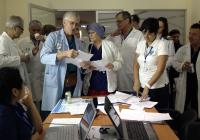
Letter from Guatemala: Indy-Area Physicians Engage in Joint Effort
Editor’s Note: Our correspondent, Alex Farris, is a research writer with the Center for Hip & Knee Surgery in Mooresville. As part of Operation Walk, he recently traveled to Guatemala with a surgeon from the clinic, Dr. Merrill Ritter, and agreed to update IM with a series of dispatches. Here is his first.
DAY ONE
Seguro. It’s the Spanish adjective for “safe.” With the verb estar (“to be,” roughly translated), it can also mean “to be sure.” And feeling sure I wasn’t, at least not as the day unfolded.
I left Indianapolis this morning for Guatemala on a medical trip. The clinic where I work, the Center for Hip & Knee Surgery in Mooresville, organizes a trip every year as part of Operation Walk, which goes to countries like Cuba, Nicaragua, Ecuador, and Russia, and provides orthopedic surgery for people who normally would have no access to it. This year, an interpreter spot opened up, and since I speak Spanish, I was able to join the doctors traveling to help patients in Central America.
When we got to the hotel in Guatemala City, I put on some scrubs I had bought at Goodwill. Over those, I would have to wear a pristine white lab coat. It’s a requirement for anyone working in our hospital in Guatemala, whether you’re a lead surgeon, a technician, or, like me, a translator who has no business in an operating room. I put on the white coat, and immediately I felt Very Important. I would not be implanting any artificial hips, but it felt like I could. I would comfort the afflicted, maybe even give people hope, and I certainly would be a valuable part of this humanitarian trip, I told myself. I was on top of the world.
That was before I got to the hospital.
We took a bus to Amatitlan, a town an hour southeast of Guatemala City, and arrived at the hospital, but not the one were supposed to have had. Originally, we were slated to use the military hospital in the city, and we had the entire surgery schedule set up more than a month beforehand. But at the last minute, we had to move our operations to this hospital an hour away.
Having a new pool of potential patients meant that we had to do some old-fashioned triage. We walked into the hospital, and I saw at least 50 people waiting to be examined and evaluated. Depending on the doctors’ examinations, each patient would either be cleared for joint replacement or receive non-operative treatment, such as braces and physical therapy, from local doctors.
I had never worked in a clinic before (I usually stay back in the research department of the Mooresville clinic), so this was entirely new to me. And I wasn’t sure exactly what to do. The original plans, the ones regarding patients we had already known about and scheduled, called for me to give simple post-operative instructions on how long to keep from walking, when to use a brace, and when to return to a reasonable level of activity after surgery. Now, the triage required me to relay the doctors’ diagnoses.
The first patient went very easily. It was a simple diagnosis—total left hip replacement—and while I forgot the word for replacement (reemplazo), I powered through and even used some complex sentence structure. I was feeling pretty confident.
Translating for the second patient, however, did not go so well. She had suffered a fall three years earlier, causing her kneecap to slide out of place and, if I understood correctly, down between her shin and thighbone. She had used a knee brace for a time, but she said using the brace hurt more than walking on crutches without it. The doctor had me tell her that too much time had elapsed between the accident and now, and that a knee replacement would do more harm than good, compared to non-surgical treatment.
This was hard to tell her. She kept saying that she could hardly walk as she was, and she asked more than once why an artificial knee wouldn’t work. I can do well in a simple, straightforward translation, but work some sad emotion into it, and I make sentences like this:
“No esta …” Five-second pause. “No esta …” Five-second pause. “Eh …” Five-second pause. “No es una buena idea reemplacer la rodilla.” (“It isn’t a good idea to replace your knee.”)
This is where I needed seguro. I wanted to tell her that it wouldn’t be safe to operate on her so long after her accident, but her pleading reduced me to a stuttering mess, unsure of what to say.
Fortunately, the third patient was an easier case. It wasn’t cut-and-dried, but I at least knew how to tell him to lift his leg and ask him how he hurt his hip. I regained my surety. And I got inspired watching the doctors make post-examination decisions. At least 10 of the best orthopedic surgeons in the country gathered in one room and, almost faster than I could comprehend, evaluated x-rays as a group and made their schedules for the next day. Listening to them expertly debate which hip replacement would work best in which patient made me feel better about the uncertainties of the day. And, despite my missteps, I was even able to help out a bit in their diagnoses.
I think I’ll be more sure tomorrow.
Read about Day Two of Farris’s trip here.
Alex Farris has worked as a photographer for the Indiana Daily Student and, currently, the Lafayette Journal and Courier.
Photos by Alex Farris. View more at his website.







